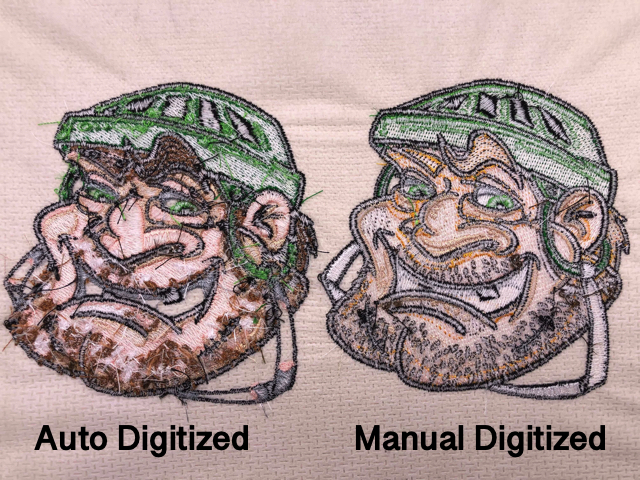Understanding the Needlework Digitizing Refine: Your Ultimate Overview
Needlework digitizing is a meticulous craft that calls for precision and know-how to translate intricate designs right into electronic layouts for device needlework. As artisans embark on this trip to grasp the needlework digitizing procedure, an extensive understanding of the essentials establishes the structure for quality. Beyond the basic understanding lies a world of sophisticated software application, specialized devices, and nuanced methods waiting to be checked out. By delving right into the nuances of digitizing, one can open a globe of imaginative opportunities and elevate their needlework jobs to new elevations.

Understanding Embroidery Digitizing Fundamentals
Needlework digitizing basics form the structure upon which complex layouts are equated into machine-readable formats for exact stitching. This preliminary action in the needlework digitizing process is important for making certain that the last stitched product is a loyal depiction of the original style. Comprehending needlework digitizing fundamentals includes grasping key concepts such as stitch types, stitch instructions, thickness, padding, and pull payment.
Sew kinds play an essential duty in identifying the aesthetic and textural result of the embroidered layout. By choosing the ideal stitch kind, whether it be satin, fill, or running stitch, digitizers can achieve the desired effect and improve the total top quality of the needlework. Additionally, sew instructions affects the flow and measurement of the design, while thickness determines the spacing and protection of the stitches.
In addition, padding sewing supplies stability to the layout by protecting the fabric and preventing distortion during the needlework procedure. Draw compensation is another important consideration to neutralize the natural tendency of material to agreement when sewn. Grasping these embroidery digitizing fundamentals is essential for creating professional-quality stitched products.
Picking the Right Digitizing Software Program
Choosing the proper digitizing software program is a critical choice that considerably impacts the effectiveness and quality of the needlework digitizing procedure. Digitizing for Embroidery. When choosing the appropriate digitizing software application, it is important to consider variables such as the intricacy of designs you prepare to create, the user-friendliness of the software, the level of consumer assistance supplied, and the compatibility with your embroidery machine
There are numerous digitizing software application alternatives available on the market, ranging from fundamental programs for beginners to innovative software program for expert digitizers. Some popular options consist of Wilcom EmbroideryStudio, Hatch Needlework Software, and PulseID. These software offer a wide variety of tools and functions to assist you develop intricate layouts effortlessly.
Before making a choice, it is recommended to explore the various software options with free tests or demos to identify which one ideal suits your requirements. Furthermore, reading evaluations and seeking referrals from skilled this page digitizers can offer useful understandings right into the strengths and weak points of each software plan (Digitizing for Embroidery). By carefully reviewing your demands and contrasting the functions of various digitizing software, you can make an educated go to website choice that improves your embroidery digitizing operations
Digitizing Devices and Strategies

Optimizing Style Setup for Needlework
Understanding the details of layout setups is fundamental in achieving optimum results in the embroidery digitizing process, building upon the foundation laid by understanding digitizing devices and methods. When maximizing design setups for needlework, it is vital to take into consideration variables such as stitch type, density, padding, pull compensation, and enrollment. Registration settings align different aspects of the design properly, keeping overall layout integrity.

Troubleshooting Common Digitizing Issues
When coming other across typical digitizing concerns throughout the needlework procedure, it is necessary to comprehend the origin and carry out reliable solutions immediately. One common trouble is stitch thickness concerns, where stitches may be as well dense, causing the textile to tighten, or as well thin, resulting in spaces in the layout. Readjusting the stitch thickness setups in the digitizing software can aid settle this problem.
An additional regular difficulty is string breaks throughout the needlework process. This can occur because of various reasons such as incorrect tension settings, dull needles, or making use of low-quality string. Guaranteeing proper upkeep of the embroidery equipment, including regular needle changes and stress adjustments, can lessen the event of string breaks.
Moreover, style registration mistakes can result in misaligned components within the embroidery design. Examining the style placement in the digitizing software program and making essential changes prior to sewing can assist in preventing this issue. By dealing with these typical digitizing concerns promptly and properly, you can ensure a smoother embroidery procedure and top quality ended up products.
Verdict
Finally, mastering the embroidery digitizing procedure needs a strong understanding of the essentials, the appropriate option of software program, and understanding of tools and techniques. Enhancing layout settings and repairing common digitizing issues are essential steps in making certain top notch needlework outcomes. By complying with these steps carefully, one can accomplish precision and performance in the digitizing process.